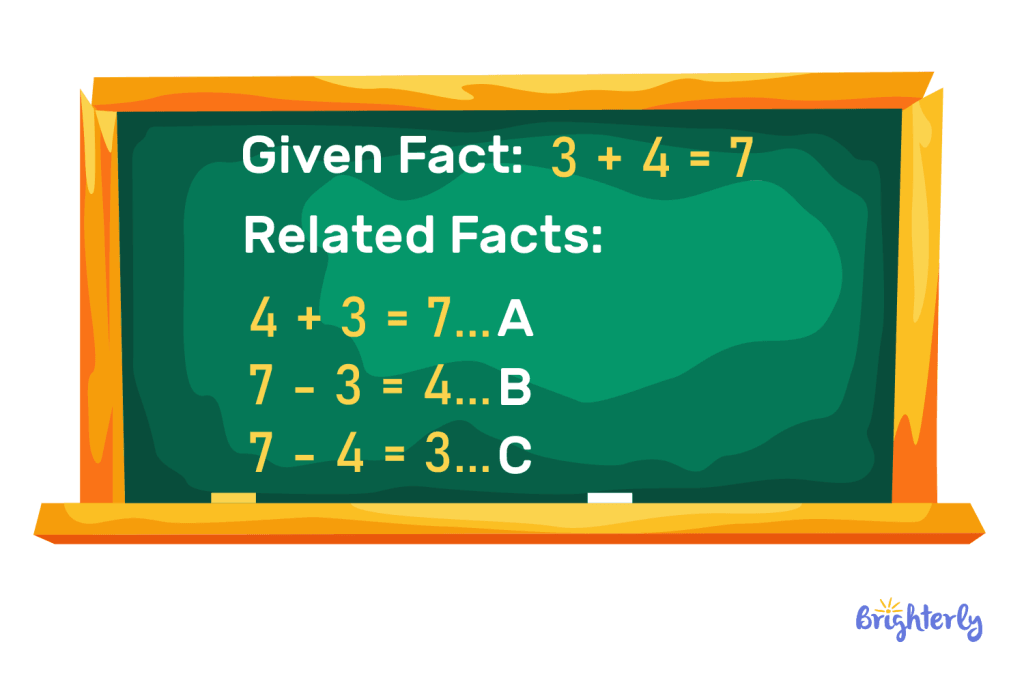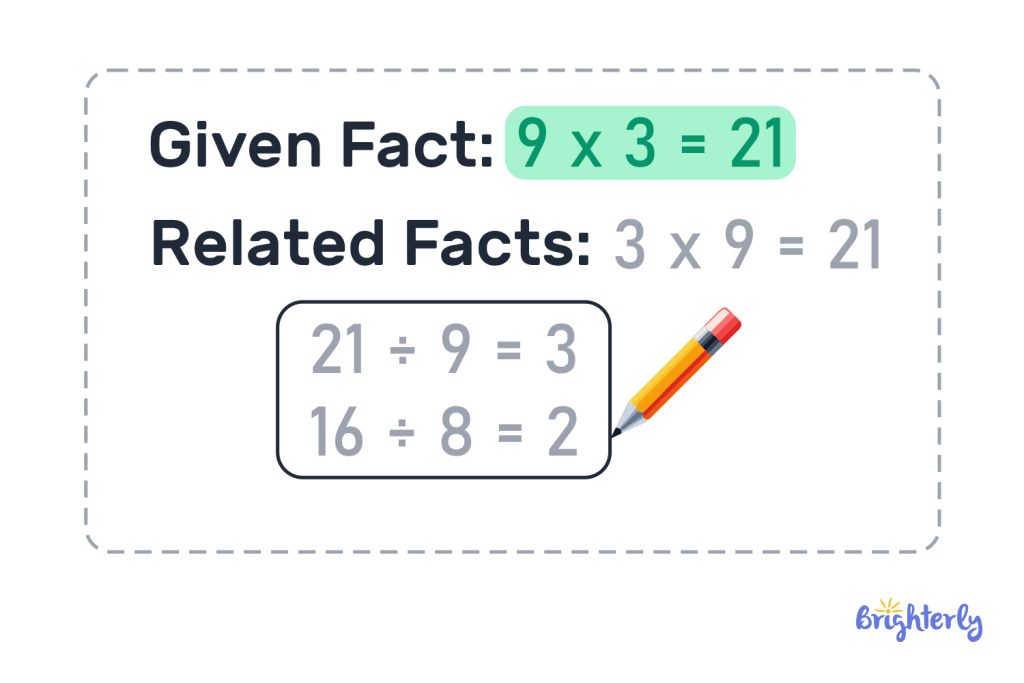Related Facts – Definition With Examples
Updated on November 3, 2025
Have you ever heard of the concept of related facts in math? You might have come across the term but not know what it means — well, you’re in the right place!
Here, we’re going to cover what are facts in math, the related facts definition, properties of related facts and how they relate to operations. We’ll also share some examples and give you practice problems to test yourself on.
What are related facts?
Related facts are equations or expressions that use the same numbers. As an example, if we have the numbers 9, 5 and 4, the equations 9 – 5 = 4 and 5 + 4 = 9 are related facts. They can also be called related equations.
Related facts highlight the relationships between inverse operations and also represent the commutative property and inverse property in math.

Definition of related facts
The definition of related facts are math facts that are related to one another through a set of numbers. Related facts use the inverse operations to your original fact. For example, if your original fact uses addition, the related fact will use subtraction. If your first fact uses division, your related facts will use multiplication.
Examples of related facts
Let’s look at some related fact examples.
It is a fact that 20 + 33 = 53. From this, we can understand the related facts of:
- 53 – 20 = 33
- 53 – 33 = 20
Now, let’s look at an example involving multiplication and division. It is a fact that 3 x 14 = 42. From that, our related facts are:
- 42 ÷ 3 = 14
- 42 ÷ 14 = 3
Properties of related facts
Related facts align with two number properties in math:
- Commutative property, which states that the order of your numbers in an addition or multiplication equation can swap around, and the result will be the same
- Inverse property, which states that the inverse of an operation (i.e. division for multiplication) will give results using the same numbers
Understanding the nature of related facts
The nature of related facts help us understand the relationship between numbers and operations in math. Using them, we can understand the inverse relationship of numbers and operations, which is a foundational piece of math knowledge.
Properties of addition and subtraction in related facts
Addition and subtraction are inverse operations, meaning that all facts involving addition will have a related subtraction fact. That’s also true in reverse. So, if you ask, “What is a related subtraction fact of 7 + 8 = 15?”, this will be:
- 15 – 8 = 7
- 15 – 7 = 8
Properties of multiplication and division in related facts
In the same way that addition and subtraction are inverse operations, so too are multiplication and division. This means that all facts using multiplication will have related facts that use division, and division equations will have a related multiplication equation. E.g. the related facts of 3 x 9 = 21 are:
- 21 ÷ 9 = 3
- 21 ÷ 3 = 9

Equations involving related facts
You can use the following equations to understand related facts:
Addition: If a + b = c, the related facts equations will be:
- c – a = b
- c – b = a
Subtraction: If a – b = c, the related facts equation will be:
- c + b = a
Multiplication: If a x b = c, the related facts equations will be:
- c ÷ a = b
- c ÷ b = a
Division: If a ÷ b = c, the related multiplication facts will be:
- c x b = a
Writing equations with related facts: Addition and subtraction
Using the above equations, let’s write some related facts using the numbers 8 and 2.
Addition: Our fact is 8 + 2 = 10. This means our related facts are:
- 10 – 8 = 2
- 10 – 2 = 8
Subtraction: Our fact is 8 – 2 = 6. This means our related addition fact is:
- 6 + 2 = 8
Writing equations with related facts: Multiplication and division
Now, let’s write some related facts using multiplication and division with the same numbers:
Multiplication: Our fact is 8 x 2 = 16. This means our related facts are:
- 16 ÷ 8 = 2
- 16 ÷ 2 = 8
Division: Our fact is 8 ÷ 2 = 4. This means our related fact is:
- 4 x 2 = 8
Related facts: Practice problems
Now it’s time to try it out for yourself! These practice problems will help you refine your skills in answering questions about related facts math. Either work out the answers mentally or write them down:
- What is the related addition fact and subtraction related fact for the following numbers: 15, 12 and 27?
- Work out the multiplication and division related facts for the following numbers: 12, 3, 4
- Work out every related fact for the following numbers: 30, 10 and 3
Conclusion
Here, we’ve covered the related facts meaning, their properties, examples and practice questions. Now, you can confidently approach any questions covering related facts! You will also be able to use this knowledge in other areas of math, including algebra.
Related facts: Frequently asked questions
What are math facts?
Math facts are basic calculations that will always be true, making them a fact. For example, 3 + 4 = 7 is a math fact. It is a simple addition calculation that will always be true.
What is a related fact in math?
A related fact in math is the inverse operation of a math fact. For example, the related facts of 3 + 4 = 7 are 7 – 3 = 4, and 7 – 4 = 3.
Why are related facts important in mathematics?
Related facts are important in mathematics because they help you understand the relationships between numbers and operations. Understanding them gives you the foundational knowledge to spot patterns, solve problems and make predictions.
How can practicing related facts help improve problem-solving skills?
Practicing related facts improves problem-solving skills because they support the key skills of number sense and pattern recognition. Once you grasp these concepts, you can move onto more complex math problems.
Are related facts relevant only to addition and subtraction or multiplication and division?
Yes, related facts are relevant to inverse operations. This means the related facts of an addition equation will be subtraction equations, and vice versa. The related facts of multiplication equations will be division equations, and vice versa.






